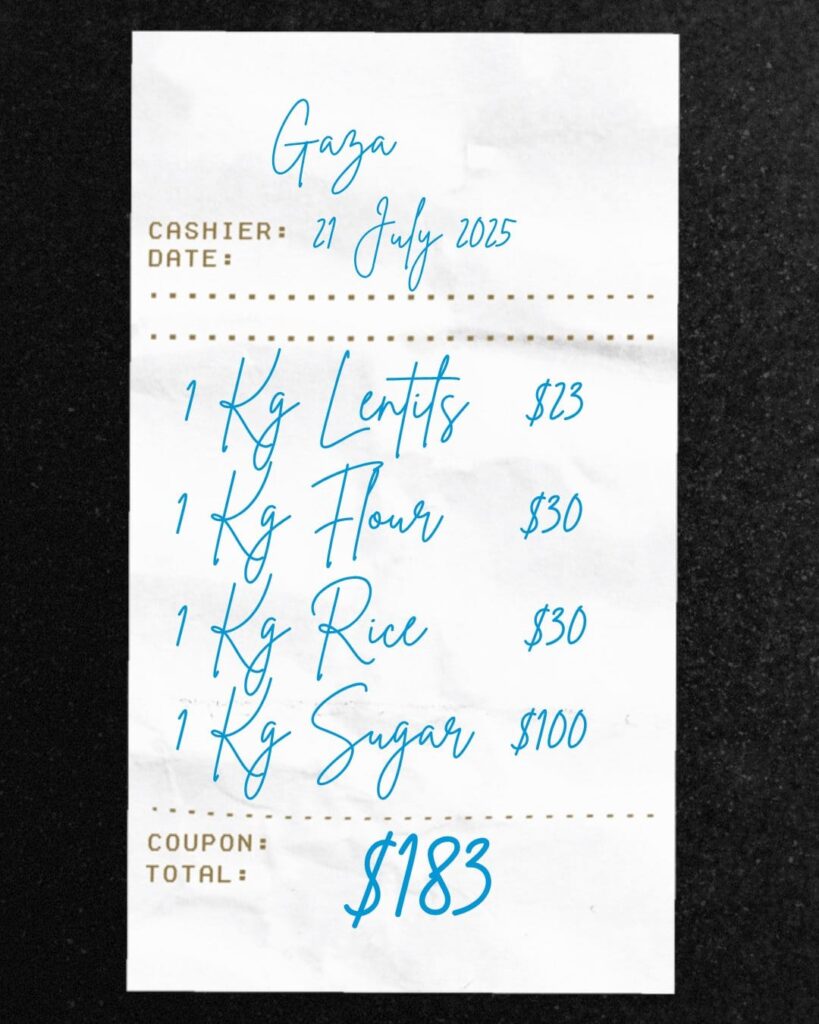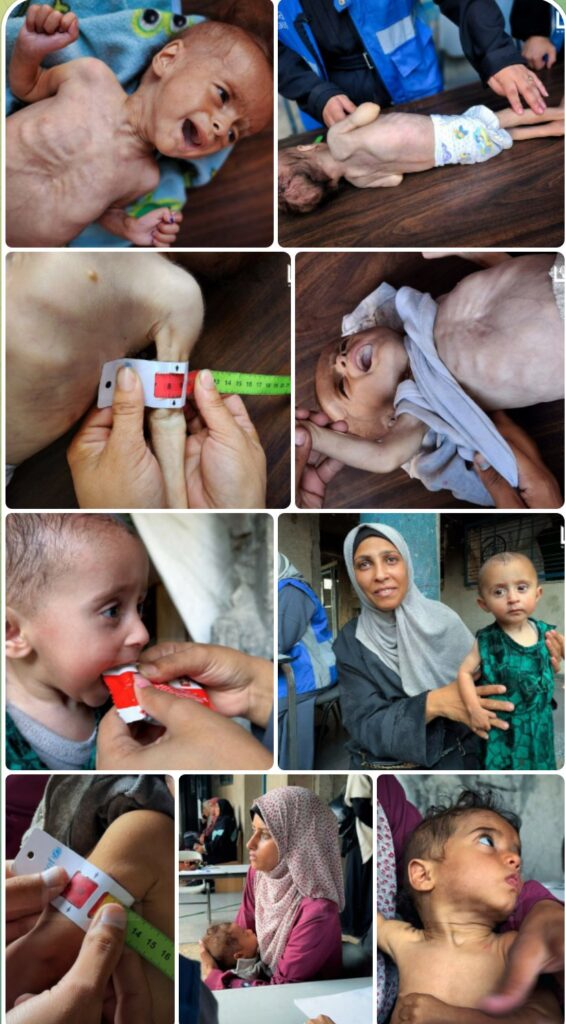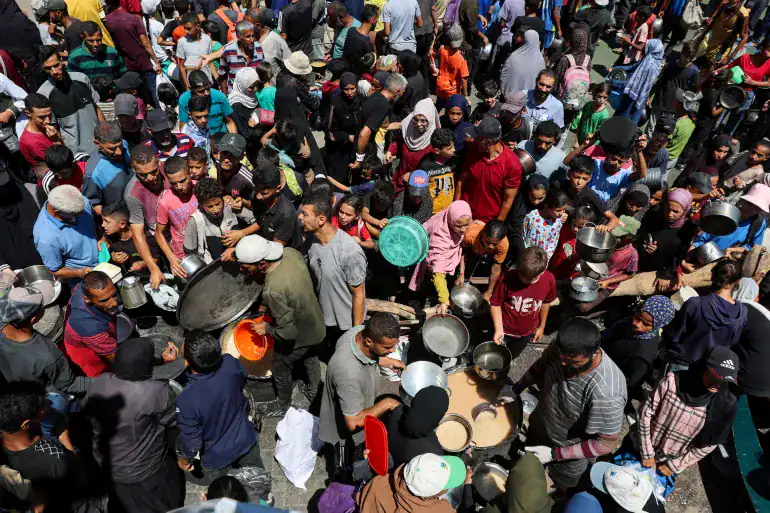
Gaza Strip: More than two million Palestinians in Gaza are reportedly facing an unprecedented humanitarian crisis, with many starving as the region nears full-scale famine. Humanitarian organisations say access to food, medicine, and clean water has been critically restricted due to Israel’s blockade, which they blame for the worsening famine.
Since March 2, 2025, Israel has imposed a near-total blockade on Gaza. Although limited aid has been allowed in since May, the United Nations Relief and Works Agency for Palestine Refugees (UNRWA) said it has been barred from delivering food since March despite having enough supplies stockpiled to feed Gaza’s population for three months. Even UNRWA’s own staff in Gaza are now struggling to eat.
Food prices soar as hunger spreads
Meanwhile, even basic items like bread, rice, and sugar are either missing or too expensive to buy in Gaza. A single piece of bread now costs 3 dollars. One kilogram of sugar is marked at a 100 dollars, while rice and flour are each priced at 30 dollars. Lentils cost around 23 dollars—bringing the total for just five staple items to a staggering 183 dollars (about Rs 15000). These prices represent an increase of more than 4,000 percent, leaving families unable to afford even the most basic sustenance.

Taking to X, UNRWA wrote, “Crowds of starving men, women, and children in Gaza wait for little food. Some people go for days without eating… This is a man-made and politically motivated starvation of a people. Lift the siege.”
The agency also warned that one million children in Gaza are being starved because humanitarian aid remains blocked.

UN: Starvation in Gaza is politically driven
UNRWA has issued multiple urgent appeals. “This is a man-made and politically motivated starvation of a people,” the agency said, calling on the international community to lift the siege.
UNRWA Commissioner-General Philippe Lazzarini added, “Daily SOS messages are coming in from our colleagues. It shames me and doubles the sense of helplessness. Inaction is complicity and makes us lose our humanity.”
A video posted by TRT on July 10 shows a hungry Palestinian child approaching her father with an empty plate, unable to sleep from hunger.
Gaza Humanitarian Foundation sites turn deadly
The Gaza Humanitarian Foundation (GHF), which began operations in late May, has become a focal point in the deepening crisis. Backed by both governments, the group bypasses the traditional UN-led aid system, which Israel and the US accuse of being exploited by Hamas—an allegation the UN strongly denies.

According to UN figures, nearly 900 Palestinians have died in recent weeks while attempting to access humanitarian aid—most at or near GHF-run sites. Though the GHF claims to have delivered millions of meals, distribution has frequently turned violent and chaotic, with civilians facing gunfire, stampedes, and exposure to military action.
One video shows Israeli forces using pepper spray on Palestinians trying to get food.
Another clip from July 19, captures children scrambling over pots and fleeing as Israeli tanks advance near an aid site in Rafah.
Food production and livelihoods destroyed
Gaza’s food production systems have collapsed. According to a June 2025 report submitted to the UN Security Council by the Food and Agriculture Organization (FAO), over 70 percent of agricultural land has been destroyed or made unusable by Israeli airstrikes and a lack of essential supplies like water, seeds, and fertilisers.
The livestock sector has experienced near-total collapse—95 percent of animals have perished due to starvation or untreated illness. The fishing industry is also devastated. More than 80 percent of boats are inactive due to Israeli-imposed maritime restrictions. Several fishermen have been killed, injured, or arrested, including four detained off the coast of Gaza on July 19.
Hospitals are overwhelmed. Doctors report rising cases of people fainting in the streets from exhaustion and hunger. The World Health Organization (WHO) warns that over 650,000 children under five are at severe risk of acute malnutrition, along with tens of thousands of pregnant women.
“There’s no strength left in these bodies,” a Gaza Health Ministry spokesperson said. “Hundreds face death simply because their bodies can no longer resist the hunger.”
Doctors and health workers say the situation is worse than ever. Dr Munir Al-Bursh from Gaza’s Health Ministry said, “In Gaza, food is no longer a right. It’s an unfulfilled wish whispered by mothers at night and drawn in the eyes of hungry children. Bread has become a lost treasure.”
Global solidarity and a cry for help
Palestinian journalist Motaz Azaiza, now outside Gaza, used his platform to highlight the crisis. Walking through New York, he wore a shirt that readq, “Please don’t take my picture with food. My people are starving.”
In a social media post, he quoted poet Mahmoud Darwish: “When you prepare your breakfast, think upon others… such as those who live in tents.” His message resonated globally, reflecting the voice of a displaced, starving population.
More than 59,000 Palestinians, most of them women and children, have been killed since October 7, 2023. Ceasefire calls go unanswered. And Gaza continues to starve—in silence, under siege.



